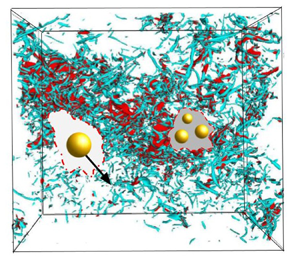Published online by Cambridge University Press: 03 December 2021

In this work we introduce a Lagrangian stochastic model for particle motion and evaporation to be used in large-eddy simulations (LES) of turbulent liquid sprays. Effects of small-scale intermittency, usually under-resolved in LES, are explicitly included via modelling of the energy dissipation rate seen by a droplet along its trajectory. Namely, the dissipation rate is linked to the norm of the droplet sub-filtered acceleration which is included in the droplet motion equation. This norm, along with the direction of the droplet sub-filtered acceleration, is simulated as a stochastic process. With increasing Reynolds number, the distribution of the sub-filtered acceleration develops longer tails, with a slower decay in auto-correlation functions of the norm and direction of this acceleration. The stochastic models are specified for particles larger and smaller the Kolmogorov length scale. The assumption of the droplet evaporation model is similar, i.e. the evaporation rate is strongly enhanced when a droplet is subjected to very localized zones of intense velocity gradients. Thereby, the overall evaporation process is assumed to be a succession of two steady-state sub-processes with equal intensities, i.e. evaporation and vapour mixing. Then the stochastic properties of the overall evaporation rate are also controlled by fluctuations of the energy dissipation rate along the droplet path, and with increasing Reynolds number, the intensity of fluctuations of this rate is also increasing. The assessment of the presented stochastic models in LES of high-speed non-evaporating and evaporating sprays show the accurate prediction of experimental data on relatively coarser grids along with a remarkably weaker sensitivity to the grid spacing. The joint statistics and Voronoi tessellations exhibit strong intermittency of evaporation rate. The intensity of turbulence along the droplet pathway substantially promotes the vaporization rate.